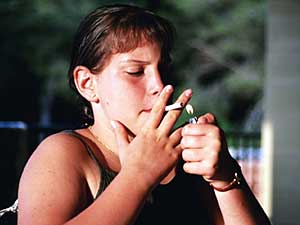|
Audio
Photos
More from MPR
Resources
Your Voice
|
Youth smoking shows troubling increase
January 22, 2004
A Health Department report says more young adults in Minnesota are smoking than originally thought. The report says 39 percent of 18 to 24 year olds have smoked cigarettes at least once in the last 30 days. That's a much higher rate than adults in general. The report comes just months after the governor and Legislature used money to help balance the budget that had been set aside for youth anti-smoking programs.
St. Paul, Minn. — The Minnesota Department of Health and tobacco control groups say they're growing more concerned that young adults are not listening to anti-smoking messages. The Health Department conducted the survey with the University of Minnesota, the Minnesota Partnership for Action Against Tobacco, and Blue Cross Blue Shield of Minnesota. They interviewed nearly 9,000 adults between November 2002 and June 2003.
They found that one-third of Minnesota's young adults -- people between the ages of 18 and 24-- consider themselves established smokers. That means they have smoked at least 100 cigarettes in their lifetime, and now smoke every day or some days. That's more than double the percentage of Minnesotans 25 years old and older who consider themselves established smokers.
 | |||
"We're troubled by a couple of things," says Pete Rode, a research scientist with the Minnesota Department of Health. "One is that the smoking rate is still very high among young adults. But secondly, we now know that there are some smokers -- admitted infrequent smokers among the young adult population -- who were never counted in previous adult smoking surveys."
Rode says the survey also found that 7 percent of young adults don't consider themselves established smokers, but they have smoked at least once in the past 30 days. He says those people are likely to become established smokers. The health department says tobacco-related illnesses now cost Minnesotans $1.6 billion annually.
Jeremy Hanson with the Minnesota Smoke-Free Coalition says he's not surprised by the findings. He says Minnesota had a high youth smoking rate in the 1990s, but it started to drop after the state settled a lawsuit against several tobacco companies in 1998. Hanson says Minnesota set aside $1 billion from the settlement in an endowment, to help fund medical research and smoking prevention programs for teenagers.
State lawmakers and Gov. Pawlenty spent that money last year to help balance the state's budget. Although the survey was done before the money was cut, Hanson says without the endowment he's concerned that more teens and young adults will start smoking.
 | |||
"During the time that the state was committed to tobacco prevention, and funded programs through the youth tobacco endowment, we saw the first time in over a decade the first reduction in teen smoking rates," says Hanson. "And now that most of those programs have been eliminated, I'm afraid we're going to see history repeat itself."
Hanson says he would like to see state lawmakers increase the cigarette tax, place a greater emphasis on creating smoke-free environments, and spend more money on smoking cessation programs. He says that would reduce the number of people who smoke.
State Rep. Phil Krinkie, R-Shoreview, says he's not happy about the increase in smoking, but says eliminating the tobacco endowments was necessary to balance the budget. Krinkie says because of the tobacco settlement, the state has other smoking cessation programs.
"Just because we spend more money doesn't mean we're going to be able to get that result," says Krinkie. "So there are probably other things we need to look at as well as merely spending money on smoking cessation programs, or programs that will encourage youth, hopefully, not to start smoking."
The report also found that more people want to quit smoking. Steven Foldes with Blue Cross Blue Shield of Minnesota says 56 percent of Minnesota's adult smokers tried to quit in the year before the survey was conducted. That's 10 percent higher than in 1999.
Foldes says he's pleased that more people are trying to quit, but is troubled that they're trying to do it cold turkey. He says it's much harder to quit without the use of things like the nicotine patch. He also says HMOs and MPAAT are offering help to people at little or no cost.
"There is a gap between the level of interest expressed by smokers in quit aids when we ask them if cost were not an issue, and the actual use by smokers who are using real-life quit attempts," says Foldes.
Foldes and other researchers say it's necessary for HMOs and state lawmakers to lower the use of tobacco statewide, especially if they're concerned about lowering the cost of health care.
|
News Headlines
|
Related Subjects
|

